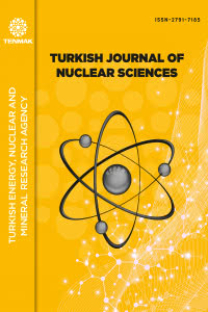FRAKSİYONEL DİSTİLASYON İLE OKSİJEN - 18 İZOTOPUNUN ZENGİNLEŞTİRİLMESİ
Bu çalışmada, vakum altında çalışan 200 cm yüksekliğinde ve 3 cm çapında fraksiyonel su destilasyon kolonu tasarlanmış ve pyrex camdan imal edilmiştir. Kolon; -0.8 bar, 52° C’de 120-140 ml/dk buharlaşma/yoğunlaşma ve 0.5-10 ml/dk besleme hızlarında damıtılmış su (distilated water) ile çalıştırılmıştır. Oksijen-18 izotop oranlarının analizi İzotop Oranı – Kütle Spektrometresi (IR-MS) cihazı ile yapılmıştır. Yapılan deneyler sonucunda; damıtılmış suda ki doğal O-18 izotop miktarında 28-90 ppm aralığında artış olduğu ölçülmüştür. Bu tip bir fraksiyonel su damıtma kolonunun çalışma parametreleri daha önce literatürde raporlanmamıştır çünkü bu çalışmada tasarlanan kolon sistemi literatürde bildirilen benzer kolon sistemlerinden çok daha küçüktür.
Anahtar Kelimeler:
Kararlı İzotop, Oksijen-18, Fraksiyonel Destilasyon (damıtma), İzotop Zenginleştirme, Vakum Destilasyonu
ENRICHMENT OF OXYGEN-18 ISOTOPE BY FRACTIONAL DISTILLATION
In the scope present study, fractional water distillation column operating under vacuum, with a height of 200 cm and a diameter of 3 cm, was designed and manufactured from Pyrex glass. Column was operated at an evaporation/condensation rate of 120-140 ml/min and a feed flow rate of 0.5-10 ml/min at 52 °C under -0.8 bar vacuum pressure. Oxygen-18 isotope ratios were determined using Isotope Ratio Mass Spectrometry (IR-MS). Results of the IR-MS analysis indicated that maximum relative O-18 isotope enrichment in distilled natural water was 28-90 ppm.
Keywords:
Stable Isotope, Oxygen-18, Fractional Distillation, Isotope Enrichment, Vacuum Distillation,
___
- Ageev E .P., Panchenkov G.M. (1963). The Separation of Oxygen Isotopes by Thermal Diffusion. Translated from Atomnaya Energiya, 14, 5, 494-6.
- Dostrovsky I., Hughes E. D., Llewellyn D. R. (1948). Fractional Distillation and Its Application in the Concentration of The Heavy Isotopes of Oxygen and Hydrogen. Nature, 161, 858-9. doi:10.1038/161858a0
- Dostrovsky I., Llewellyn D. R., Vromen B. H. (1952). The Separation of Isotopes by Fractional Distillation. I. Fractionating Columns for The Enrichment of the Heavy Isotopes of Oxygen in Water. J. Chem. Soc., 3509-17. doi:10.1039/JR9520003509
- Kistemaker J., Bigeleisen J., Nier A.O.C. (Eds.). (1957). Separation of The Heavy Isotopes of Oxygen by Distillation. Proceedings of the International Symposium on Isotope Separation. New York: Interscience.
- Goncharuk V.V. (2014). Drinking Water, Physics, Chemistry and Biology. Switzerland: Springer International Publishing. doi: 10.1007/978-3-319-04334-0
- Huffman J. R., Urey H. C. (1937). Separation of Oxygen Isotopes by a Fractionating Column. Ind. Eng. Chem., 29, 531-5. doi: 10.1021/ie50329a011
- Khalil, M. M. (Ed.).(2017). Basic Science of PET Imaging. Switzerland: Springer International Publishing.
- Kim J., Chang D. S., Choi Y. Y. (2009). Separation of Oxygen Isotopic Water by Using a Pressure-Driven Air Gap Membrane Distillation. Ind. Eng. Chem. Res., 48, 11, 5431-8. doi: 10.1021/ie900277r
- Kim J.W., Choi H.-R., Chang D.-S., Choi Y.-Y., (2008). Method For Stable Oxygen Isotope Separation and Its Apparatus Using Membrane Distillation, US 2008/0185283 A1.
- Lewis G. N., Cornish R. E. (1933). Separation of the Isotopic Forms of Water by Fractional Distillation. J. Am. Chem. Soc., 55, 2616-7. doi: 10.1021/ja01333a518Ogden G. (1935). Electrolytic Separation of the Oxygen Isotopes. Nature, 136, 912. doi: 10.1038/136912a0
- Pop F., Piciorea I., Iliescu M., Culcer M., Croitoru C., Stefanescu I. (2006). Experimental Plant For 18O Separation by Cryogenic Oxygen Distillation. Annuals of the University of Craiova, Electrical Engineering Series, 30, 399-403.
- Takashi K., Hitoshi K. (2009). Method and Apparatus for Enrichment of Heavy Oxygen Isotopes, US2009266702 (A1).
- Taylor T.I., Bernstein R. B. (1947). Enrichment of C13 And C14 by a Countercurrent Gaseous Exchange Process Using Thermal Diffusion. J. Am. Chem. Soc., 69, 2076-2076. doi: 10.1021/ja01200a523
- Tetsuro M., Kyoko S. (1994). Method for enrichment of oxygen 18 with a laser, US5314592(A).
- Thode H. G., Smith S. R., Walkling F. O. (1944). The Separation of the Oxygen Isotopes by the Distillation of Water. Can. J. Res., 22, Sec.B, 127-136. doi:10.1139/cjr44b-016.
- Başlangıç: 1981
- Yayıncı: -
Sayıdaki Diğer Makaleler
SİLİNDİRİK EYLEMSİZ ELEKTROSTATİK SIKIŞTIRMALI FÜZYON CİHAZINDA ALINAN DENEYSEL SONUÇLAR
Arife Seda BÖLÜKDEMİR, Betül YASATEKİN, Emre COŞGUN, İhsan KILIÇ, Yeşim OLGAÇ, Ali ALAÇAKIR
FRAKSİYONEL DİSTİLASYON İLE OKSİJEN - 18 İZOTOPUNUN ZENGİNLEŞTİRİLMESİ
Selen Nimet GÜRBÜZ GÜNER, Haydar DİŞBUDAK, Erhan AKSU, Mahmut EKEN, Filiz KARACAN
YUNAN-TÜRK SINIRINDA HIGGS FABRİKASI: BÖLGESEL BİR PROJE
Serkant Ali ÇETİN, Saleh SULTANSOY, Gökhan ÜNEL, Bora IŞILDAK, Fatih Ömer İLDAY, Konstantin ZİOUTAS, Konstantinos KORDAS, Chariclia PETRİDOU, Evangelos GAZİS, Yannis K. SEMERTZİDİS
Alper Nazmi YUKSEL, Serdar BULUT, Nihal Oyku Serin, Erdal RECEPOGLU
